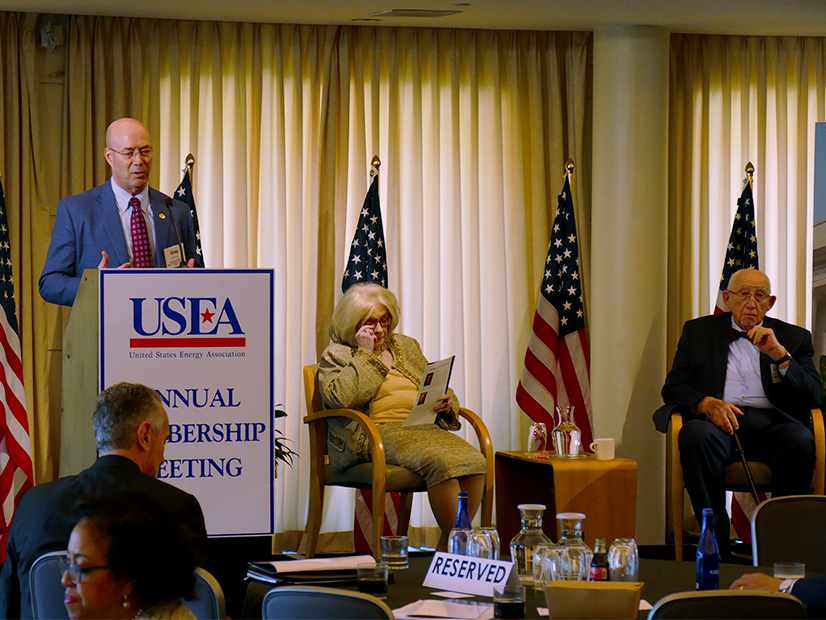
WASHINGTON – The United States Energy Association saw a change of leadership and heard from speakers on the transition to clean energy at its Annual Membership Meeting and Public Policy Forum last week.
Acting USEA Executive Director Sheila Hollis, of Duane Morris, has run the organization since longtime Executive Director Barry Worthington died in 2020. She announced her term was coming to an end and that she would be replaced by former U.S. Deputy Energy Secretary Mark Menezes.
NARUC’s White Speaks on the Role of the States
“We have an international programs department, and Sheila has heard me say this many, many times,” said Greg White, executive director of the National Association of Regulatory Utility Commissioners. “I consider us to be a partner with USEA. USEA does training for the utilities around the world. And we go into those exact same countries, and we train the regulators.”
NARUC has worked in more than 50 countries in its history and is currently helping 30 with their regulatory systems, he said. White’s first overseas trip was to the country of Georgia, where he helped fix its creaky, post-Soviet grid.
“Everybody in the country was carrying a flashlight with them because in the Soviet-era buildings, the elevators usually didn’t work,” White said. “And so, people had to walk up many flights of stairs in the dark to get to their apartments.”
Now the Georgian grid is reliable 24/7, and the days of always needing a flashlight are over, he said. That is what drives regulators here and abroad — bringing light to the world, he said. The challenge now is to make the grid’s transition happen without major issues.
“We’re trying to get cleaner energy that is sustainable, reliable, resilient and affordable,” White said. “And we need to balance all those interests.”
Most of the progress that has been made on clean energy in recent years is because of state and local policies, but now much of the conversation in D.C. on permitting reform would strip those states of at least some of their authority to site transmission lines.
“We’ve got some proposals in Congress right now that, quite frankly, would eviscerate the role of the states and permitting new infrastructure, especially as it pertains to the much needed electric transmission infrastructure,” White said. “We believe that that would be a mistake because the states have considerably more success at siting infrastructure than the federal government.”
NARUC’s engagement with FERC has been more fruitful, with White highlighting the Joint Federal-State Task Force on Electric Transmission as helping to reach common policies needed to make the energy transition work.
The ‘Materials Transition’
Another aspect of the clean energy transition that was not addressed much by major legislation last Congress is materials, said Michelle Foss, fellow at Rice University’s Baker Institute for Public Policy.
“I’m going to take a modicum of credit for the phrase ‘materials transition,’” Foss said. “The idea that the energy transition is a materials transition is because I pushed to get minerals on the agenda of an international meeting last year. And we were successful in that, and now I’m finding this phrasing is rolling around.”
The conference was in Tokyo, and the Japanese government has been pushing the issue to the forefront. Foss said the G7 nations are now actively pursuing the issue.
“My own view on this is that you put materials first,” Foss said. “But we didn’t do that. We rolled out an enormous spending program, sending people off in all manner of directions trying to do things that they can’t do, because we don’t have the material supply chains to support them. And that … is energy policy in the United States.”
Foss is an alumna of the Colorado School of Mines. When she was there in the 1980s, the domestic mining industry was dying, and now it has essentially given up all of its capacity, she said. Labor and compliance with environmental laws, which brought benefits, have made the business generally too expensive here, so it moved overseas.
“China constitutes 44%, in our math, of total tonnage of nonfuel minerals in the world today, everything from metals to non-metals, to construction materials — they are it,” she said. “This is not their fault; it’s ours. We gave up our capacity, and China took a market share.”
The U.S. is going to need secure supply chains of many minerals as it transitions to a clean economy, replacing equipment and infrastructure as they wear out, said Foss.
While much of the focus in the energy industry involves a shift away from carbon, Foss said that the element was going to be important forever because it is also used to make superior and cheaper materials that can replace metals.
“If I can displace metals with that, then I’m simply doing what humans have been doing for decades now, which is displacing metals with plastic, but a better form of it; a more advanced form of it,” Foss said.

